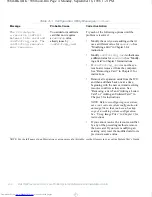
Installing Drives
7-3
The drive’s interface connector is a card-edge connector
or a header connector, as shown in Figure 7-5.
Figure 7-5. Drive Interface Connectors
Most interface connectors are keyed for correct insertion;
that is, a notch or a missing pin on one connector matches
a tab or a filled-in hole on the other connector. Keying
ensures that the pin-1 wire in the cable (indicated by the
colored strip along one edge of the cable) goes to the
pin-1end of the connector on each end.
The pin-1end of a card-edge connector is usually
identified by a notch cut about a quarter of an inch in
from the end of the connector, as shown in Figure 7-5. A
header connector is usually keyed by the omission of one
of its pins (see Figure 7-5), with the corresponding hole
filled in on the connector on the cable.
The pin-1 end of a connector on a board or a card is usu-
ally indicated by a silk-screened “1” printed directly on
the board or card.
I
nstalling a Drive in the 5.25-Inch
Drive Bay
The 5.25-inch drive bay can accommodate any of the fol-
lowing types of drives:
•
A diskette drive or tape drive that uses the diskette/
tape drive interface on the system board
•
A CD-ROM or tape drive that uses the secondary
EIDE interface on the system board
•
A CD-ROM or tape drive that uses its own controller
card
NOTE: For information on configuring, connecting, and
installing SCSI drives, see “Installing SCSI Devices”
found later in this chapter.
To install a drive in this drive bay, follow these steps:
1.
Unpack the drive and prepare it for installation.
Ground yourself by touching an unpainted metal sur-
face on the back of the computer, and unpack the
drive. Check the documentation that accompanied
the drive to verify that the drive is configured for
your computer system. Change any jumper and
switch settings necessary for your configuration.
NOTE: If you are installing a non-EIDE tape drive,
check the documentation for the drive to determine
the jumper or switch settings used to designate the
drive as drive address DS4 (not DS2 or DS3 as may
be indicated in the drive documentation). Unless the
drive is already set to drive 4, reconfigure its jumper
or switch setting (see “Jumpers” and “Switches” in
Chapter 5).
If you are installing an EIDE CD-ROM or EIDE tape
drive, configure the drive as a master drive or single
drive, depending on the particular drive.
2.
Remove the computer cover as instructed in
“Removing the Computer Cover” in Chapter 5.
CAUTION: When connecting an interface cable,
do not reverse the interface cable (do not place the
colored strip away from pin 1 of the connector).
Reversing the cable prevents the drive from
operating and could damage the controller, the
drive, or both.
header connector
on drive
interface
cable
card-edge connector
on drive
colored
strip
CAUTION: See “Protecting Against Electro-
static Discharge” in the safety instructions at
the front of this guide.
93816BK0.BK : 93816c70.frm Page 3 Monday, September 16, 1996 1:21 PM






























